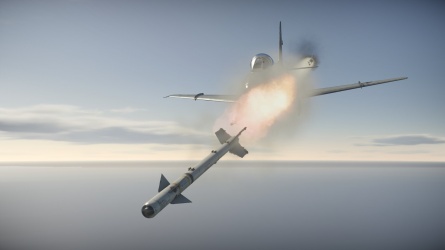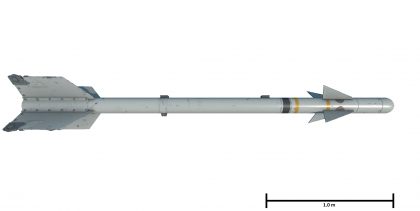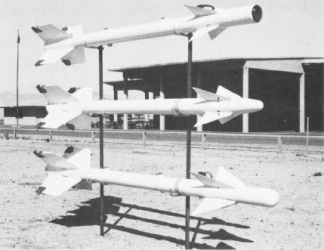AIM-9B Sidewinder
| This page is about the American air-to-air missile AIM-9B Sidewinder. For other versions, see AIM-9 Sidewinder (Family). |
Contents
Description
The AIM-9B Sidewinder is an American infrared homing air-to-air missile which was introduced in Update 1.85 "Supersonic". The AIM-9B is the earliest and least capable member of the Sidewinder family of missiles found in the game. It was the basis for the later Sidewinder missiles, as well as many other missiles found in the game. The Rb24 is an AIM-9B built under license in Sweden, while the R-3S, R-13M1 and PL-2 are all descendants of the Vympel R-3 missile, which was a Soviet reverse-engineered version of the AIM-9B. The AIM-9B also served as the basis for the design of the Israeli Shafrir missile, although there are notable differences between the two.
Vehicles equipped with this weapon
| Vehicles equipped with this weapon | |
|---|---|
| Jet fighters | |
| USA | F3H-2 · F4D-1 · F-4C Phantom II · F8U-2 · F-8E |
| F9F-8 · F11F-1 · F-100D · F-104A · F-104C | |
| Germany | ◄CL-13B Mk.6 · ◄F-86K · ◄F-104G · ◄G.91 R/4 · ◄Sea Hawk Mk.100 |
| Britain | Scimitar F Mk.1 |
| Japan | F-86F-40 ▅ · F-86F-40 JASDF▅ · F-104J · T-2 Early · T-2 |
| China | ␗F-86F-40 · ␗F-100A · ␗F-100F · ␗F-104A · ␗F-104G |
| Italy | ▄F-86K · ▄F-104G · F-104S · ▄F-104S TAF · G.91 R/4 · G.91 YS |
| France | ◘Sea Hawk Mk.50 · Super Mystere B2 · ␙Super Mystere B2 · ▄F-86K · ▄F-100D · ▄F-104G · ▄F-8E(FN) · ◘Hunter F.6 · Milan · Mirage IIIC · Mirage IIIE · ▄Mirage 5BA · Mirage 5F |
| Strike aircraft | A-4B · A-4E Early · A-4E Early (M) · A-4E · Buccaneer S.2 · Etendard IVM · FJ-4B · FJ-4B VMF-232 · F-105D · F-111A |
General info
Like other early air-to-air missiles, the AIM-9B is limited in is destructive capabilities. Although it contains enough explosive filler to eliminate or cripple an enemy given a direct hit, those direct hits may be hard to come by. For one, this missile only has a 10G overload. Therefore, it is quite easy for an enemy to dodge it. All the enemy needs to do is to turn slightly, and the missile will likely miss. For greatest lethality, use this missile on slow targets that cannot manoeuvre well (though, in this case, guns may be just as effective).
Still, as one of the first air-to-air missiles in the game, the missile is quite effective for dealing with enemies in the right circumstances. Careful positioning and trigger discipline are required. In lower-tier jet combat, the AIM-9B is the gold standard for long to medium range air-to-air combat.
| Missile characteristics | |
|---|---|
| Mass | 72 kg |
| Guidance | IR |
| Aspect | Rear-aspect |
| Lock range (rear-aspect) | 4 km |
| Launch range | 10 km |
| Maximum speed | 1.7 M |
| Maximum overload | 10 G |
| Missile guidance time | 20 secs |
| Explosive mass (TNT eq.) | 7.62 kg |
Effective damage
With a 4.76 kg HBX explosive (7.62 kg TNT equivalent) warhead, the AIM-9B Sidewinder can ensure the destruction of the hit aircraft's tail section. Even a near-miss with the proximity fuse detonating can cause significant damage to the rear control surfaces so that a critical hit will cause the plane to lose air controllability, leading to a credit when the plane eventually smashes into the ground.
Comparison with analogues
- AIM-9B FGW.2 Sidewinder - A European-licensed version of the AIM-9B with their own improvements; however the performance in-game are quite similar.
- R-3S/PL-2 - Infamous as a reverse-engineered variant of the AIM-9B, the R-3 missile shares many of its in-game performances with the AIM-9B, only falling slightly short in locking and launching range.
- Shafrir - Shares in-game performance values despite their design differences
- Rb24 - Licensed-produced version of the AIM-9B for the Swedish, and as such shares in-game performance values.
| Missile | Guidance | Lock range (rear-aspect)(km) |
Launch range (km) |
Maximum speed (Mach) |
Maximum overload (g) |
Mass (kg) |
TNT Equivalent (kg) | |||||
|---|---|---|---|---|---|---|---|---|---|---|---|---|
| Type | Aspect | Time | Uncaged seeker | Radar slaving | ||||||||
| |
AIM-9B Sidewinder | IR | Rear | 20 | |
|
4 | 10 | 1.7 | 10 | 72 | 7.62 |
| |
AIM-9C Sidewinder | SARH | Front | 60 | |
|
9 | 18 | 2.5 | 18 | 95 | 4.69 |
| |
AIM-9D Sidewinder[note 1] | IR | Rear | 20 | |
|
5.5 | 18 | 2.5 | 18 | 88 | 4.69 |
| |
AIM-9E Sidewinder[note 2] | IR | Rear | 20 | |
|
5.5 | 18 | 2.8 | 10 | 76 | 7.62 |
| |
AIM-9G Sidewinder | IR | Rear | 60 | |
|
5.5 | 18 | 2.5 | 18 | 88 | 3.53 |
| |
AIM-9H Sidewinder | IR | Rear | 60 | |
|
5.5 | 18 | 2.5 | 18 | 88 | 3.53 |
| |
AIM-9J Sidewinder[note 3] | IR | Rear | 40 | |
|
5.5 | 18 | 2.5 | 20 | 76 | 7.62 |
| |
AIM-9L Sidewinder | IR | All | 60 | |
|
11 | 18 | 2.5 | 30 | 84 | 4.58 |
| |
AIM-9M Sidewinder | IR | All | 60 | |
|
11 | 18 | 2.5 | 30 | 84 | 4.58 |
| |
AIM-9P Sidewinder | IR | Rear | 40 | |
|
5.5 | 18 | 2.5 | 20 | 76.93 | 7.62 |
| |
AIM-9P4 Sidewinder | IR | All | 40 | |
|
11 | 18 | 2.5 | 20 | 76.93 | 7.62 |
| |
AIM-9B FGW.2 Sidewinder | IR | Rear | 20 | |
|
5.5 | 10 | 1.7 | 10 | 72 | 7.62 |
| |
Shafrir | IR | Rear | 20 | |
|
7 | 10 | 1.7 | 11 | 65 | 7.62 |
| |
RB24 | IR | Rear | 20 | |
|
4 | 10 | 1.7 | 10 | 72 | 7.62 |
| |
R-3S | IR | Rear | 21 | |
|
9 | 10 | 1.7 | 10 | 75 | 8.8 |
| |
PL-2 | IR | Rear | 21 | |
|
9 | 10 | 1.7 | 10 | 75 | 8.8 |
Usage in battles
This missile is best utilised when trailing an enemy. This will allow the pilot enough time to close the distance and acquire a target lock before firing the missile. The AIM-9B is especially effective against jet bombers, such as the Vautour IIA IDF/AF (France), which generally have poor manoeuvrability.
The missile can hit targets at up to 2.7 km of range if they are moving in a straight line and make no effort to dodge. You can use this to your advantage by launching at aircraft high above you, who believe themselves to be safe due to their altitude, and may thus neglect to check their rear.
Firing the missile at aircraft moving in a straight line less than 900 m away usually guarantees a kill, as by the time the target can react to the missile, it is already upon them.
When firing this missile, watch out for nearby friendly aircraft, and for the sun. The missile may lock onto either of these, causing at the best a miss, and at worst an unintended teamkill.
The AIM-9B may be used to force the enemy to manoeuvre and bleed their speed, making it easier for the pilot to acquire a traditional firing solution and destroy the enemy with cannon fire.
Pros and cons
Pros:
- Decent effective range; can travel fairly far in a straight line to intercept
- Effective against aircraft with low manoeuvrability, aircraft compressing at high speed, and low energy targets
Cons:
- Narrow firing circle compared to later missiles with uncaged seekers
- Poorest range out of all AIM-9 variants
- Often loses track when the target manoeuvres in more than one dimension or turns sharply.
History
Development
The missile's history starts at the Naval Ordnance Test Station (NOTS) at China Lake in 1947.[1] Under William B. McLean, the missile conception sprang from mating lead-sulfide proximity fuzes that were sensitive to infrared radiation with a guidance system to home onto the infrared source.[2] Initially his own private project, McLean eventually received approval by Admiral William S. Parsons for development.[1]These missiles were first test fired in 1951, with the first air-to-air hit was made on 11 September 1953 on a drone.[3] This experimental missile would be designated as the XAAM-N-7. The missile would also earn the name "Sidewinder" by the development team, named after the desert rattlesnake that senses its prey's heat and moves in a winding motion.[1][2]
Initially a US Navy project, the US Air Force was urged into participating by Howard Wilcox, the next project lead after McLean was promoted to upper management at NOTS in 1954.[1] This culminated in a shoot-off in June 1955 between the Navy's Sidewinder against the Air Force's GAR-2 Falcon missile. The Sidewinder's performance in this event resulted in the US Air Force putting their support in the Sidewinder.[3] By May 1956, the missile was officially adopted as the AAM-N-7 for the US Navy and the GAR-8 for the US Air Force.[3][4] These designation would remain until 27 June 1963, when the Sidewinder's designations were standardised across all armed services as the AIM-9.[5]
AIM-9B
The AIM-9B (pre-1963 Navy designation AAM-N-7 Sidewinder IA) was the initial production version of the Sidewinder.[3] More than 80,000 units of the AIM-9B Sidewinder would be produced.[4]
The AIM-9B would see combat first over the Taiwan Strait in 1958, where Chinese MiGs and Taiwanese F-86 Sabres faced off in air battles. The first AIM-9B were sent in September to assist the ROC air force, which were equipped onto their Sabres.[2] The first air-to-air kill with a Sidewinder was recorded on 24 September 1958, in which a Sabre shot down a MiG-15 with an AIM-9B. During these battles, an AIM-9B Sidewinder successfully hit a Chinese MiG, but failed to explode, leaving it lodged in the fuselage. The MiG flew back to China with its baggage of an intact example of a heat-seeking missile. The AIM-9B was looked at by Soviet engineers, who reversed engineered the design into the R-3, or K-13, missile (NATO reporting name: AA-2 Atoll).[1][6]
The AIM-9B would also see widespread service in Vietnam. Its first aerial victory over Vietnam is on 10 July 1965, when two F-4C Phantom II from the 45th Tactical Fighter Squadron downed two MiG-17 with AIM-9Bs.[7] The AIM-9B would eventually account for around 28 MiG kills with 175 launches between 1965 to 1968.[8] However, the missile's limitations became more apparent overtime. The range was short, the manoeuvrability leaves a lot to be desired, the reliability is poor, and the missile's IR lock can be easily interfered by sun, cloud, and even the ground.[2][8] These problems led to continued development of the Sidewinder. The US Navy's efforts became the AIM-9D variant, while the US Air Force developed the AIM-9E.[1][3][8]
Media
- Videos
See also
- AIM-9D Sidewinder - Improved variant by the US Navy
- AIM-9E Sidewinder - Improved variant by the US Air Force
- AIM-9B FGW.2 Sidewinder
- Similar-performing missiles
External links
References
- Citations
- Bibliography
- Gervasi, Tom. America's War Machine: the Pursuit of Global Dominance: Arsenal of Democracy III. Grove Press, Inc., 1984.
- Goebel, Greg. "The Falcon & Sidewinder Air-To-Air Missiles." Air Vectors, 01 Apr. 2019, Website. (Web Archive from 12 Nov 2020)
- Hollway, Don. "The AIM-9 Sidewinder: Fox Two!" HistoryNet, Website. (Web Archive from 23 Mar 2021)
- Kopp, Carlo. "The Sidewinder Story: The Evolution of the AIM-9 Missile." Air Power Australia, 27 Jan 2014, Website. (Web Archive from 02 Apr 2021)
- Lai, Benjamin. The Dragon's Teeth: The Chinese People's Liberation Army - Its History, Traditions, and Air Sea and Land Capability in the 21st Century. Casemate Publishers, 14 July 2016.
- Parsch, Andreas. "AIM-9." Directory of U.S. Military Rockets and Missiles, Designation-Systems.Net, 09 July 2008, Website. (Web Archive from 02 Apr 2021)
- Parsch, Andreas. "Current Designations of U.S. Unmanned Military Aerospace Vehicles." U.S. Military Aviation Designation Systems, Designation-Systems.Net, 30 March 2020, Website. (Web Archive from 03 Jun 2021)
- Siemann, John W. Project CHECO Southeast Asia Report. COMBAT SNAP (AIM-9J Southeast Asia Introduction). Defense Technical Information Center, 24 Apr 1974.






